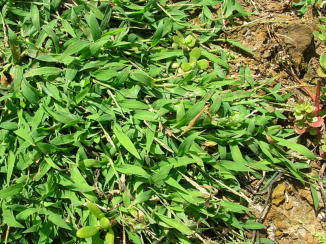
Crabgrass



Ultralawn Incorporated
1055 East 260th Street
Euclid, OH 44132
216.731.7756
440.951.3738
Office hours Monday-Friday 9-3 call today with any questions

Life Cycle: Large crabgrass, a summer annual, is a member of
the grass family. It is one of the most troublesome weeds in
lawns. Crabgrass reproduces by seedlings. A single plant is
capable of producing 150 to 700 tillers and 150,000 seeds.
Crabgrass plants are very adaptive to mowing height. Plants can
produce seeds at mowing heights as low as 1/2-inch. Crabgrass
germination is related to soil temperature. When the soil
temperature reaches 55 degrees F, crabgrass begins to
germinate. However, the soil temperature must be in this range
at least for a week. Seeds germinate best from early spring to
late summer. Crabgrass seeds are dormant for a short period of
time after they shed from plants. Crabgrass continues to grow
until midsummer when days become shorter, and vegetative
growth slows as plants enter their reproductive stage. Purplish
seed heads form until frost kills the plants. Plants that emerge early in the season and have a long period of
vegetative growth are much larger and more competitive than plants that germinate late in the season.
Habitat: Crabgrass is found in almost every situation. It is prolific in lawns, golf courses, athletic fields,
gardens, and thrives well in lawn situations. Once established, it tolerates both high temperatures and dry
weather conditions.
Description: Crabgrass is very noticeable in lawns. It is a rapid growing, coarse textured, yellowish-green
grass that is conspicuous when found growing among fine textured, dark green, cool-season turf grasses. The
stems spread outward and are very branched. Roots develop at nodes on the prostrate stems. The first leaf is
only about twice as long as it is wide. It is tinged light purple and has a white strip running down the center.
Both sides have silky, shiny hair. Leaves are 2/5- to 1/2-inch wide and 1/3- to 1-inch long. The leaf sheaths of
large crabgrass seedlings are tinged purple and are covered with long, stiff hairs. The ligule, a thin membrane
or row of hairs at the top of the junction of the leaf sheath and the leaf blade, is membranous, flat at the top
and smooth. Large and small crabgrass are the only species of the grass family which have a membranous
ligule.
Control Methods: The basic principle of a crabgrass control program is to prevent a yearly infestation of
seeds. Controlling seed production for several years will help reduce the viable seed supply. Crabgrass cannot
be controlled in one growing season because of the great number of viable seeds that accumulate in the soil
from years of infestation. A good weed management program in lawns is one that consists of both
recommended cultural practices and the use of herbicides as appropriate for the control of any given species.
Satisfactory control may require several seasons of conscientious adherence to a good control program.
Cultural Control: A thick, healthy lawn is the best way to control crabgrass and other annual weeds. The
proper mowing height, frequency, fertilization and irrigation are part of the weed control program and should
be practiced throughout the growing season. Other cultural practices are:
•
Seed in late summer or early fall for new lawns. Crabgrass and other annual grasses that germinate in
late summer will be killed by frosts in October or November.
•
Mow your lawn at a height of 3 inches. The taller grass will provide shade and keep the soil cool.
•
Proper watering is also extremely important when trying to prevent crabgrass.
Chemical Control: Crabgrass can be selectively controlled in your lawn by use of pre-emergence or post-
emergence herbicides. Timing is important for a preventative application. The best time for pre-emergence
application of herbicides is March through mid May. Post-emergence herbicides can be used when crabgrass
is in the 2nd- 5th tiller leaf stage. Repeat applications may be required depending upon the treatments.



















